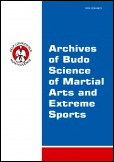2021, Volume 17, Issue 1
At the interface of gladiatorship and neo-gladiatorship: humanistic perspective in the diachronic and synchronic terms
Leon Andrzej Krzemieniecki1, Paweł Piepiora2, Kazimierz Witkowski2
1Polskie Towarzystwo Biblioterapeutyczne, Wroclaw, Poland
2Faculty of Physical Education and Sports, Wroclaw University of Health and Sport Sciences, Wroclaw, Poland
Author for correspondence: Paweł Piepiora; Faculty of Physical Education and Sports, Wroclaw University of Health and Sport Sciences, Wroclaw, Poland; email: pawel.piepiora@awf.wroc.pl
Full text
Abstract
The motto of this scientific essay is the statement that “since man has not transformed himself in a positive sense, he systematically - and to great effect - reinforces what is negative both in himself and outside”. The aim of the essay is expressing the view of the authors on the recurring phenomenon of bloody gladiator fights under a camouflaged name of mix martial arts.
Ave, Imperator, morituri te salutant. (‘Hail, Emperor, those who are about to die salute you’.) To this day, this motto is a shocking salute, once uttered by gladiators aware of their doom. Gladiatorship has a long and infamous history - bloody and deadly battles were fought in amphitheatres and circus arenas in front of the gathered audience. In ancient Rome, gladiatorship served two purposes, namely entertainment and politics. It gained notoriety among commoners. Gladiators were recruited from slaves, captives, prisoners, and former soldiers. They practiced their skills in gladiator schools and special barracks.
Decadent Rome and the beginnings of Christian communities became the plot of the novel ‘Quo Vadis’ (1896) by Nobel Prize winner Henryk Sienkiewicz, and a bestseller translated into numerous languages. The novel was filmed in many countries (Italy, USA, France, and Poland) by Jerzy Kawalerowicz in 2000. One of the most spectacular scenes is the heroic struggle of the athletic Ursus (in the Polish film adaptation this role was played by Rafał Kubacki, a two-time world champion in the open judo category) against the strength of the German aurochs in the circus arena. Lygia, the beloved one of Vinicius, was tied to the beast’s neck and horns.
In the modern history, a Korean-born master, Masutatsu Oyama (1923-1994) - actually Choi Yeong-eui - became famous for bullfighting and founded his own karate school. Gichin Funakoshi (1868-1957) ‘father of modern karate’ - under whom Oyama also practised - famously said: ‘karate ni sente nashi’ (‘no first attack in karate’) and ‘karate wa kunshi no bugei’ (‘karate is the martial art of intelligent people’).
Meanwhile, in a civilization of unprecedented technological progress, those who share responsibility for arranging spectacles where neo-gladiators massacre each other in cages, have nothing positive to offer to more (or less) intelligent people. Neo-gladiators who accept the extremely instrumental treatment of themselves and their opponent, together with the promoters of these bloody spectacles and the global audience (due to their availability via the Internet), bear witness not only to the degradation of the humanistic agon. Participation in this global phenomenon in any role is evidence of strengthening the negative within and outside. Thus, there are some open questions: what part of the human population is affected by this phenomenon? what are the dynamics of this phenomenon? is the prospect of effective counteraction real?
Key words: agon, father of modern karate, innovative agonology, “Quo vadis”





